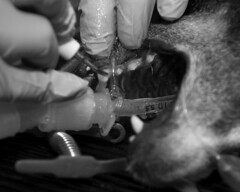We get our doggie dental work done at:
Milan Area Animal Hospital, located at
517 W. Main St., Milan, MI 48160.
Phone: (734) 439-2273.
Dog Dental Facts
• Puppies have 28 temporary teeth that erupt at about three to four weeks of age. They have 42 permanent teeth that begin to emerge at about four months.
• Symptoms of gum disease in dogs include yellow and brown build-up of tartar along the gum line, inflamed gums and persistent bad breath.
• Broken teeth are a common problem, especially among outdoor dogs. According to veterinary dental experts, aggressive chewing on hard objects, such as commercially available cow hooves, is a primary cause of broken teeth in dogs.
Oral disease is the most frequently diagnosed health problem for pets
• An astounding 80 percent of dogs and 70 percent of cats show signs of oral disease by age 3, according to the American Veterinary Dental Society (AVDS).
• Periodontal disease is a common problem in dogs, particularly smaller breeds.
Oral disease begins with a buildup of bacteria in the pet´s mouth
• Bacteria, combined with saliva and food debris between the tooth and gum, can cause plaque formulations that accumulate on the tooth. As bacteria grow in the plaque and as calcium salts are deposited, plaque turns to tartar.
• Bacterial plaque is the most important substrate in the development of periodontal disease. The inflammation and destruction that accompanies periodontal disease results from the direct action of bacteria and their by-products on periodontal tissues as well as the indirect activation of the host immune response.
• Without proper preventive or therapeutic care, plaque and tartar buildup leads to periodontal disease, which affects the tissues and structures supporting the teeth. Left untreated, periodontal disease can cause oral pain, dysfunction, tooth loss and systemic complications.
• Tartar has a contributory role due to its roughened surface, which enhances bacterial attachment and further plaque development, and also irritates gingival tissues.
Periodontitis may lead to other health problems
• Periodontal disease causes red, swollen and tender gums, receding gums, bleeding, pain and bad breath. If left untreated, periodontitis can lead to tooth loss.
• The inflammation and infection associated with periodontal disease may damage other organs such as the heart, liver, and kidneys, or lead to other serious health problems.
• Pet owners should look for warning signs of oral disease
• Common indications of oral disease include bad breath, a change in eating or chewing habits, pawing at the face or mouth and depression.
• If any of these signs are present, the pet should be taken to the veterinarian for a dental exam.
• Broken teeth are a common problem, especially among outdoor dogs. According to veterinary dental experts, aggressive chewing on hard objects, such as commercially available cow hooves, is a primary cause of broken teeth in dogs.
• The good news is that pet owners can reduce the risk of oral disease by following AVDS recommendations
• The first step in preventing oral disease is a routine physical examination including a dental exam.
• Pet owners should practice a regular dental care regimen at home, which may include brushing the pet´s teeth with specially formulated toothpaste. It´s best to start early, but grown dogs and cats can learn to tolerate brushing. Toothpaste for humans is not recommended because it may upset the pet´s stomach.
• Schedule regular follow-up care with your family veterinarian and ask about specially formulated foods with proven benefits in plaque and tartar removal.
Please visit www.petdental.com or Hill's Pet Nutrition for more information.
Sunday, February 22, 2009
Subscribe to:
Post Comments (Atom)






No comments:
Post a Comment